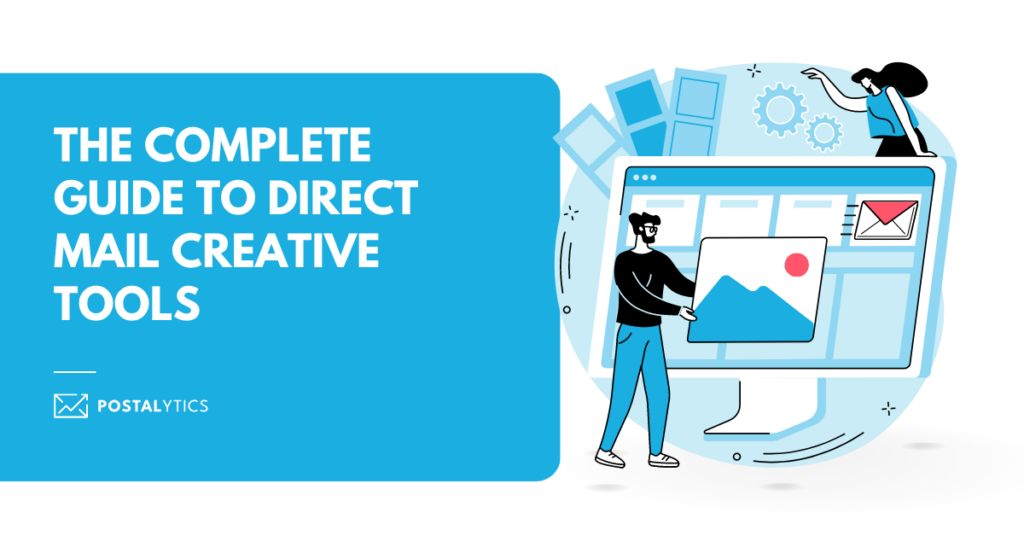
Have you ever received a direct mail that made you want to drop what you were doing to open it immediately and find out what was inside?
That’s the power of a great direct mail design.
An effectively designed direct mail piece, with the right colors, imagery and format, helps you drive your marketing message in a visually appealing way and positively impact conversions.
As a direct mail automation and creation platform, we will guide you through all the crucial steps and share tips to help your team deliver high-quality direct mail design.
What We’ll Cover:
What Is Direct Mail Design?
Direct mail design considers all the factors that create a compelling and engaging way of presenting your message.
An effective direct mail design involves selecting the right colors, photos, formats, marketing message portrayal, and brand associations that evoke curiosity and encourage the recipient to take the desired action.
It’s important that your team maintains a cohesive brand image with your direct mail pieces. For example, if they use specific color tones across other mediums, like social media and websites, the same color tones must be applied in the design of the direct mail pieces.
How to Design Direct Mail That Converts?
Creating a direct mail campaign can take up a lot of time and resources. To ensure the ROI is worth it, here are three steps to help you create designs that deliver results.
Step 1: Plan Out Your Direct Mail Piece
To start your design process, you must develop an initial outline for the piece. To create this plan, here are five things you must consider.
Understand your intended audience
Your direct mail design will change from audience to audience. For example, the images that attract SaaS buyers will differ significantly from those that attract buyers of beauty products.
Getting clear on your target audience also gives valuable insight into how much information you should be offering, the CTAs that will encourage your audience, what offers they will respond to, etc.
Define the purpose of your content
Why are you creating this direct mail? What do you want to achieve in terms of the results? The purpose of your campaign will influence the direct mail design. For example, if your goal is to increase event attendees, you must focus on why your event will help them and some exciting testimonials or offers that can back up your appeal.
Select an appropriate format
Your format will decide the amount of content and images that will fit onto the direct mail piece. If you have a lot of product information to convey, brochures or catalogs can be your best bet. On the other hand, if you are promoting an event or offering coupons, a postcard or snap pack would be a more suitable format.
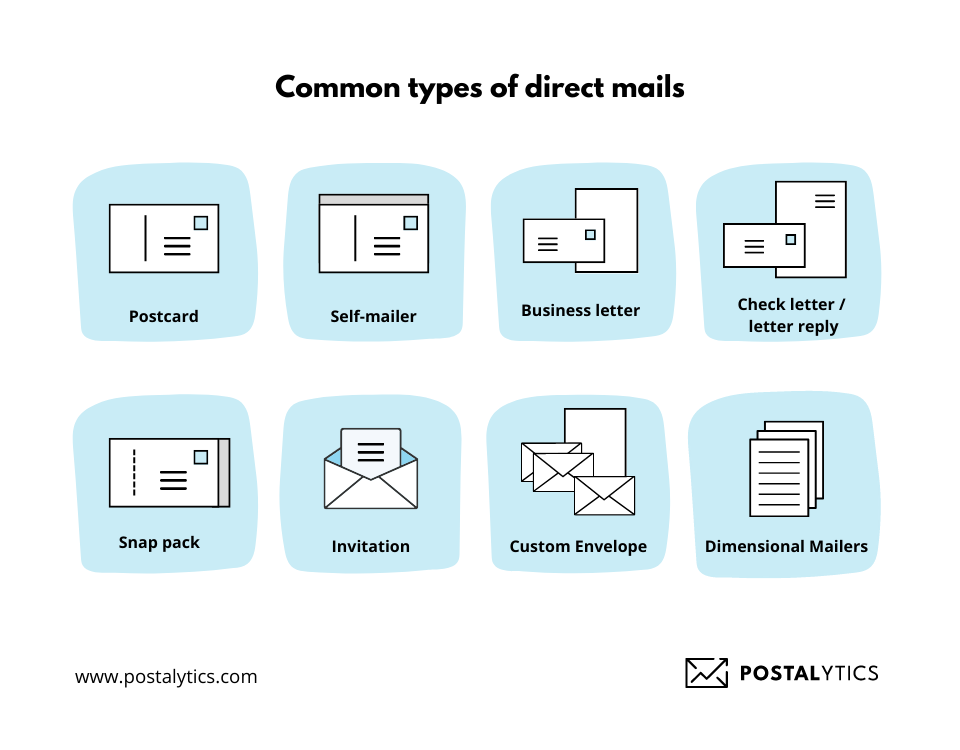
Arrange your text in a logical and engaging way
While you don’t want to bombard your audience with too much information, you want them to view all the prominent pieces of your copy, like headlines, CTAs, and other important details. So, to simplify things, ensure these details are in a larger typeface and draw more attention.
Create a grid structure to help with visual organization
A grid layout helps you properly organize all the elements of your direct mail, showing you the placement and size relative to how it will look once printed. This will help you detect problems in your direct mail design that the audience will likely trip on while viewing.
Here are three grid structures you can experiment with.
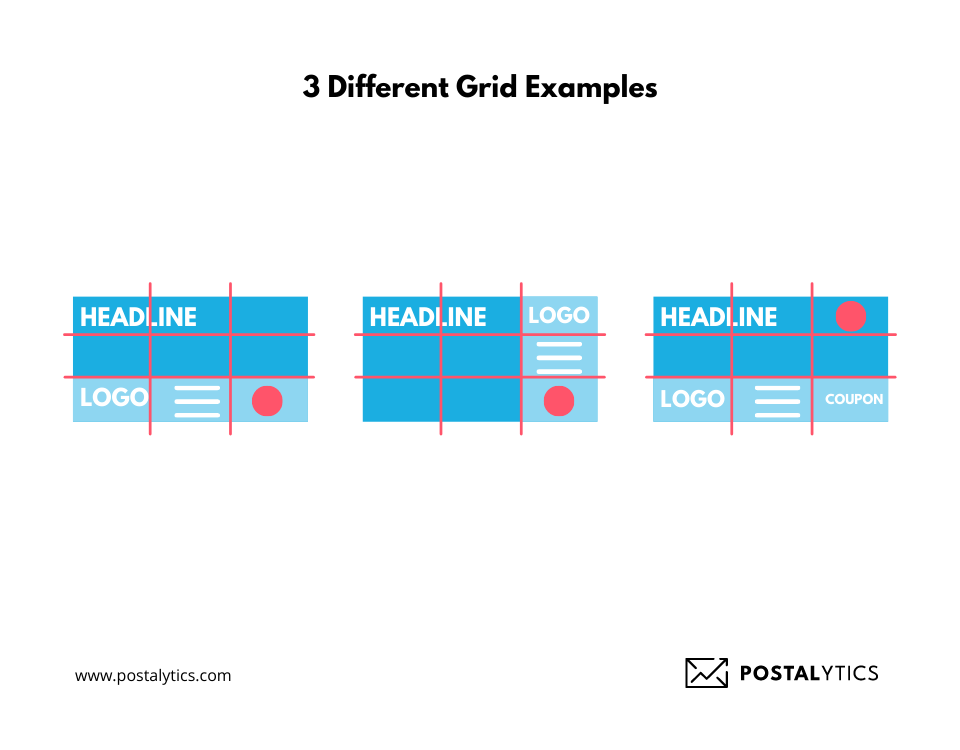
Step 2: Design Your Direct Mail Piece
Once you have finalized the plan, it’s time to begin designing your direct mail.
Strategically choose fonts
Here are three tips for selecting the fonts that go on your direct mail:
- Select the font styles you use for all your other campaigns to maintain consistency.
- Less is always more. Don’t overdo it with multiple font types; stick to one or two and vary the font sizes to denote the importance of specific copies.
- Make sure the font types you choose are easy to read.
Incorporate active white space intentionally
Nobody likes seeing cluttered mail pieces. White space is empty areas between different elements in your design that bring prominence to the most important pieces of the mail and ensures it doesn’t seem overcrowded with elements.

Effectively use imagery
Images you use online are different from those that go into print. Here are three tips you can implement:
- Use high-resolution images to make your mailers look professional and clear.
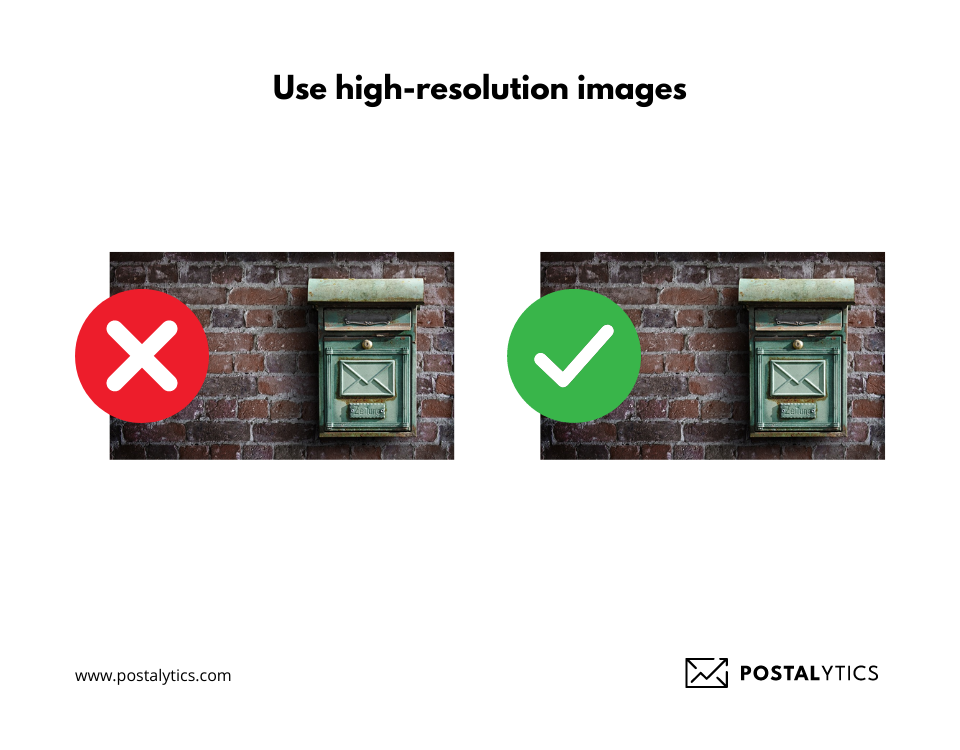
- Choose images that fit well with your message. Instead of using busy backgrounds or stock images, you can add images of your product in action.
- Ensure your text placement is proper. Avoid putting the text on top of an important element in the image.
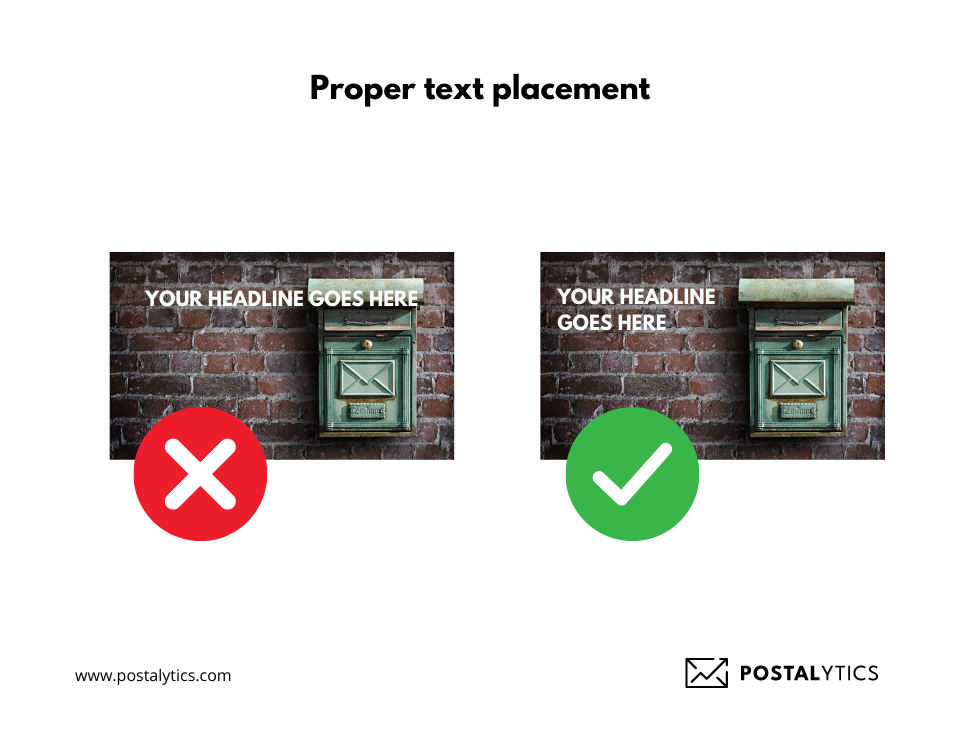
Step 3: Proof Your Direct Mail Design
Sending out direct mail with errors and inconsistencies in your design can be a costly mistake. To avoid this, don’t miss out on the final proofing step.
Proof the piece yourself
Start by proofing the piece yourself by asking the following questions:
- Does the mail piece flow properly?
- Are there any spelling or grammatical errors?
- Does the copy get unclear or confusing?
- Is the copy conveying the main point behind the purpose of the direct mail?
- Are the images clashing with the design?
You should also verify important details like the URLs, CTAs, addresses, etc.
Have it checked by others
An extra pair of eyes always helps. You can ask your colleagues and supervisors to check the direct mail and ask questions like, “Did you find something difficult to understand?” or “What do you think is the main point of this direct mail?” It can be helpful to run it by someone outside of your business to see how it lands with those without knowledge of the design.
A/B testing
If you have created multiple versions of your direct mail design, A/B test it with your teammates or selected customers to determine the kind of messaging and design that makes a greater impact.
Direct Mail Creative Tools
Postalytics provides direct mail creative tools that help you design your mail pieces quickly and effectively. Let’s look at each of them.
Direct Mail Designer
With Postalytics’ direct mail designer, you can access readymade templates based on marketing research done by skilled designers. You can customize these designs or start from scratch with our easy drag-and-drop tool that lets you easily personalize your direct mailers.
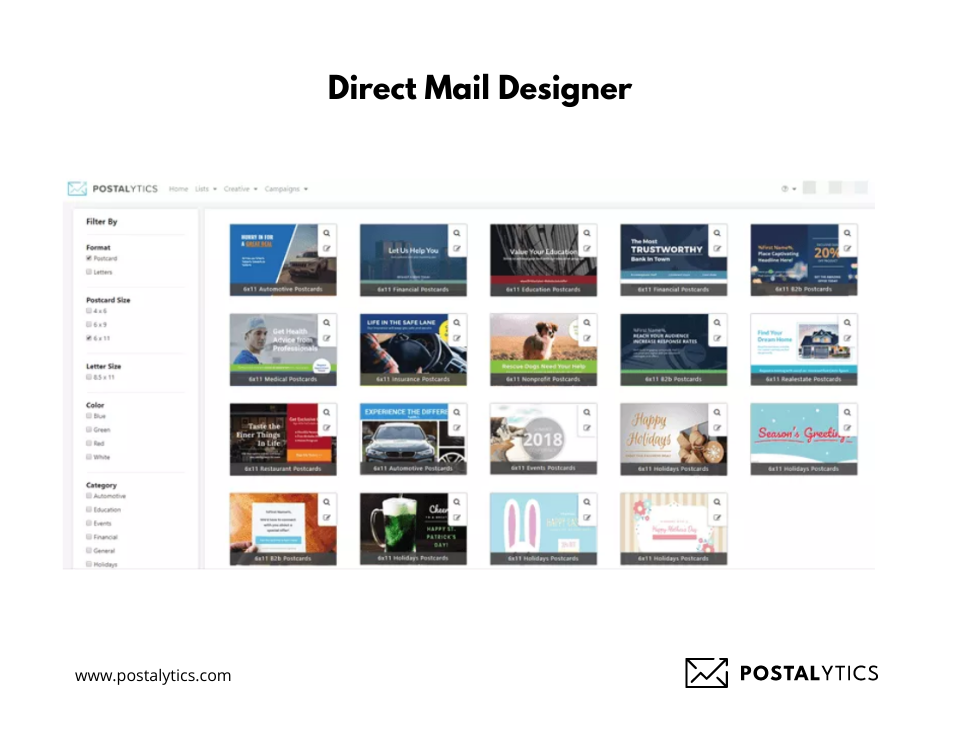
Direct Mail Proofer
The Postalytics Direct Mail Proofer helps you carefully review your template’s images, colors, fonts, and other design elements. It also uses your list or sample data to review the data inserts of the address area. The proofer also views and checks it for you if you’re using variable data personalization inserts and pURLs.
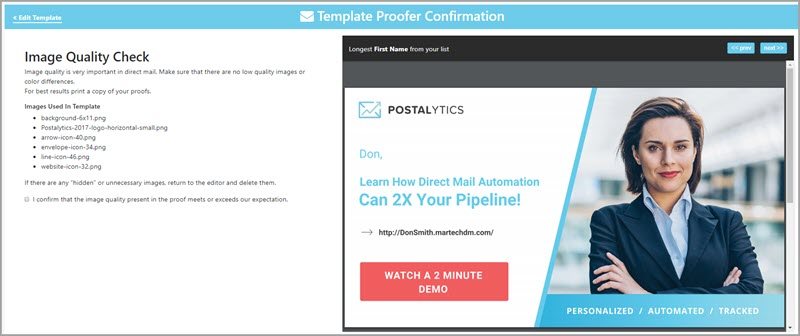
Native Variable Data Personalization
Do you want to personalize each letter or postcard you send your clients or prospects? While this could take a lot of time, the native variable data personalization tool in Postalytics helps you do this within minutes. You can use the data in your CRM or list to add a person’s name or other demographic and behavioral data. Here’s one example.
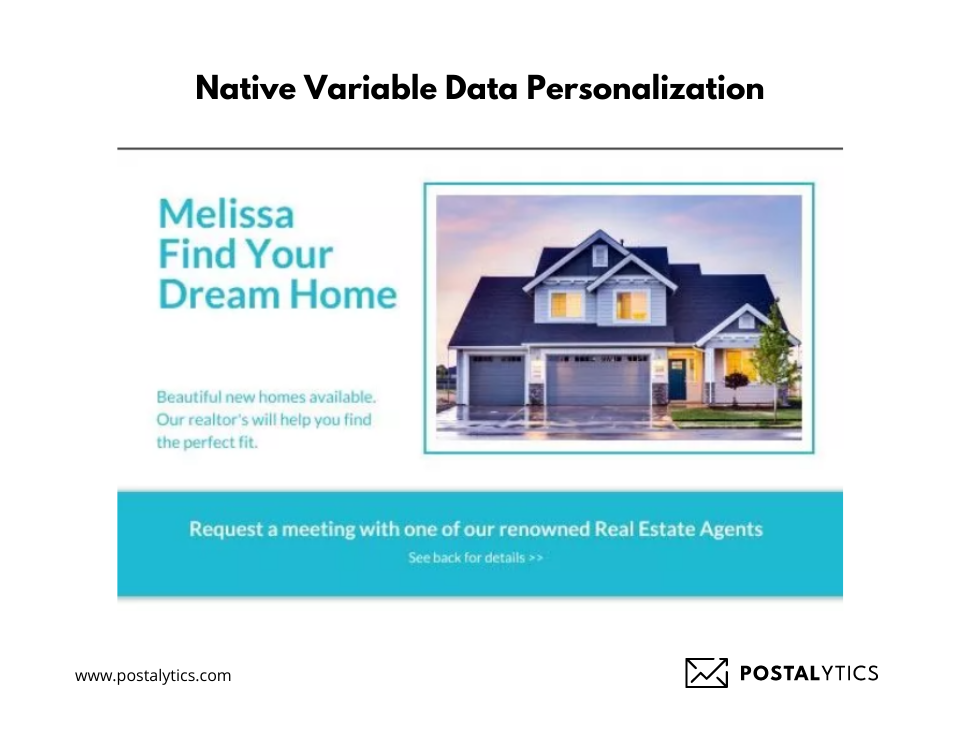
Native Variable Logic Personalization
The variable logic personalization feature uses simple IF/THEN statements to print different texts and images for different segments. This functionality allows you to create targeted campaigns that are highly relevant to the audience and leads to higher conversions.
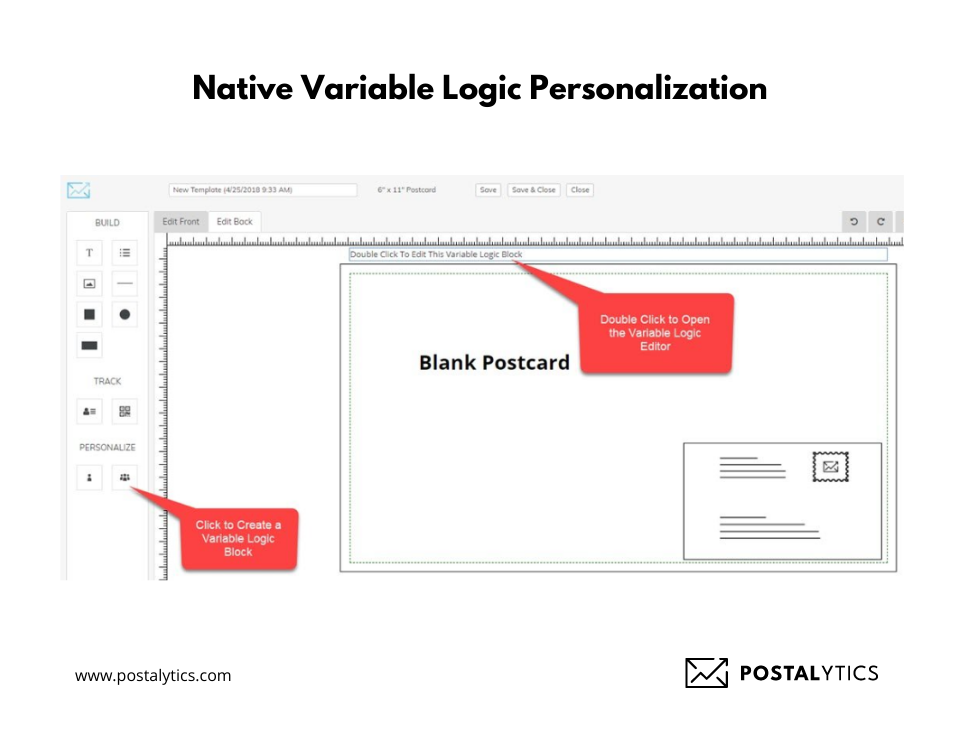
Native Variable Image Personalization
If you want to take your personalization to the next level, you can showcase different images for different target segments. With native variable image personalization, you can use variable logic or variable data to utilize this advanced personalization. You can even host these images on your pURLs.
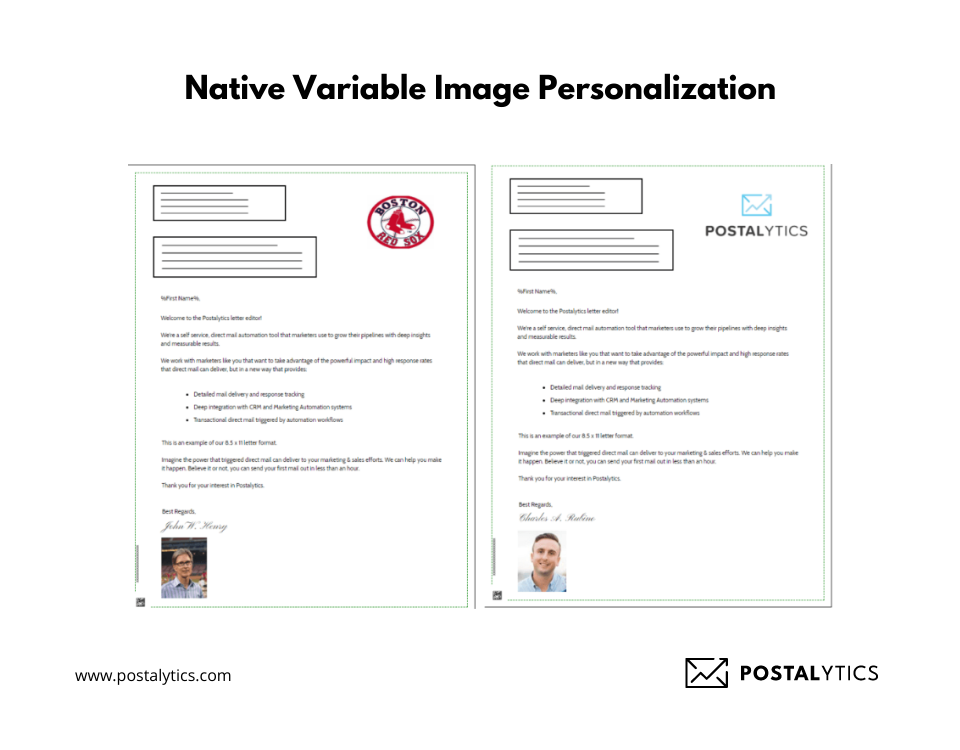
Pre-Built Templates
Whether you want to create thank you postcards or commercial real estate postcards, Postalytics has pre-built direct mail templates that can be an easy starting point for anyone who wants to create a highly professional and engaging direct mail. These templates are built after much research and testing to guarantee high conversions and evoke direct mail design ideas.
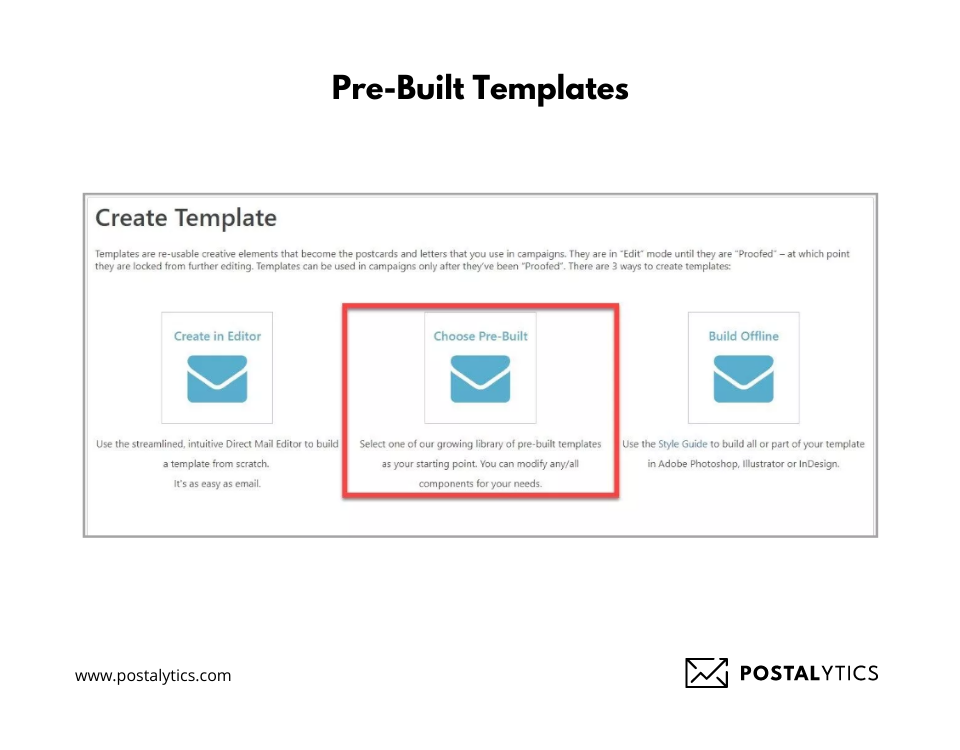
Offline Template Uploads
If your team uses Adobe Photoshop, Illustrator, or InDesign, Postalytics allows you to use the Postalytics style guide to build and customize templates offline. Once you have created the template, you can deploy your campaigns from Postalytics.
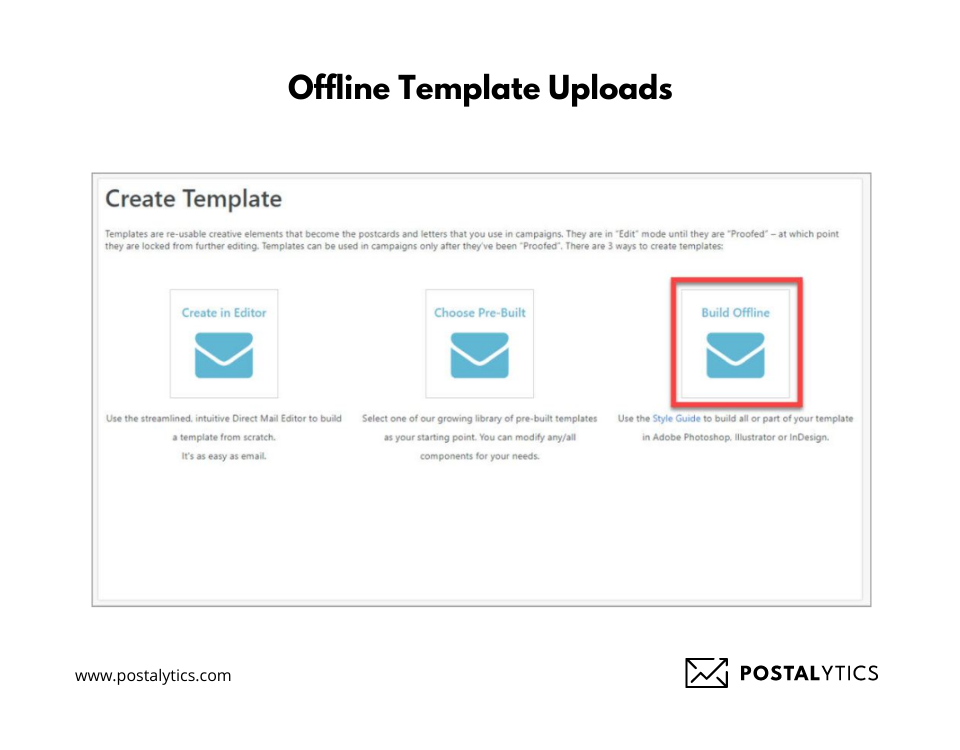
Native Asset Manager
Has your team ever scrambled to find the images they need for their campaigns? Postalytics makes this time-consuming task easy by providing a platform to upload, store, and manage files for your templates. This native asset manager can handle JPEG and PNG files that are 5 MB or below.
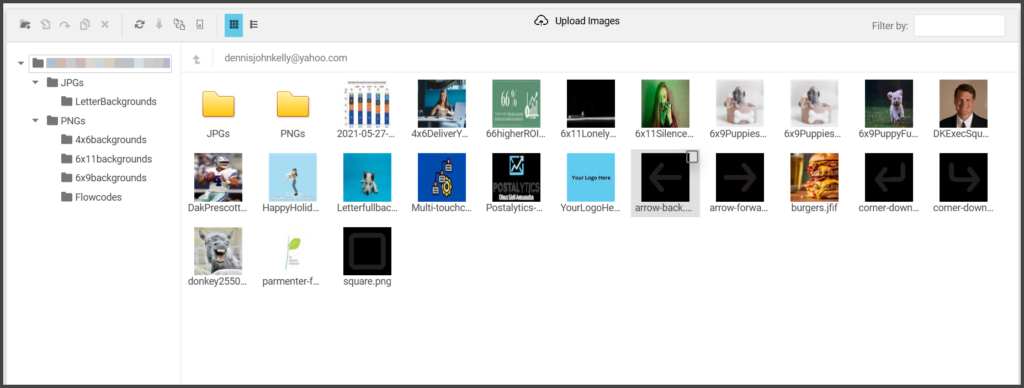
Native pURL and QR Codes
You don’t need different tools costing hundreds of dollars to generate personalized QR codes or integrate your direct mail campaigns with landing pages. With Postalytics’ native pURL and pQR codes, you can bring your recipients online and give them an easy way to respond. This also helps you track individual responses in your campaign dashboards and ensure direct mail campaign success.
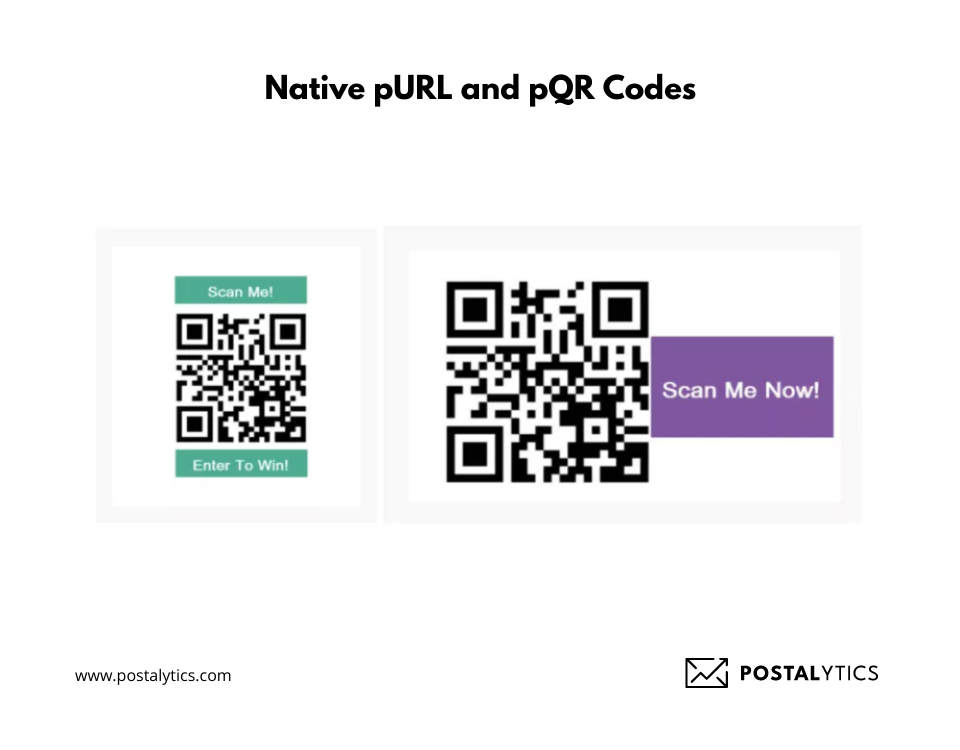
Direct Mail Postcards
Postcards are one of the most popular direct mail formats used by businesses. Postalytics offers direct mail postcards that make it easy to design a postcard campaign, print them out, send them, and measure results. You can even use readymade postcard templates, so you don’t have to pay a hefty fee to the agency for designing.
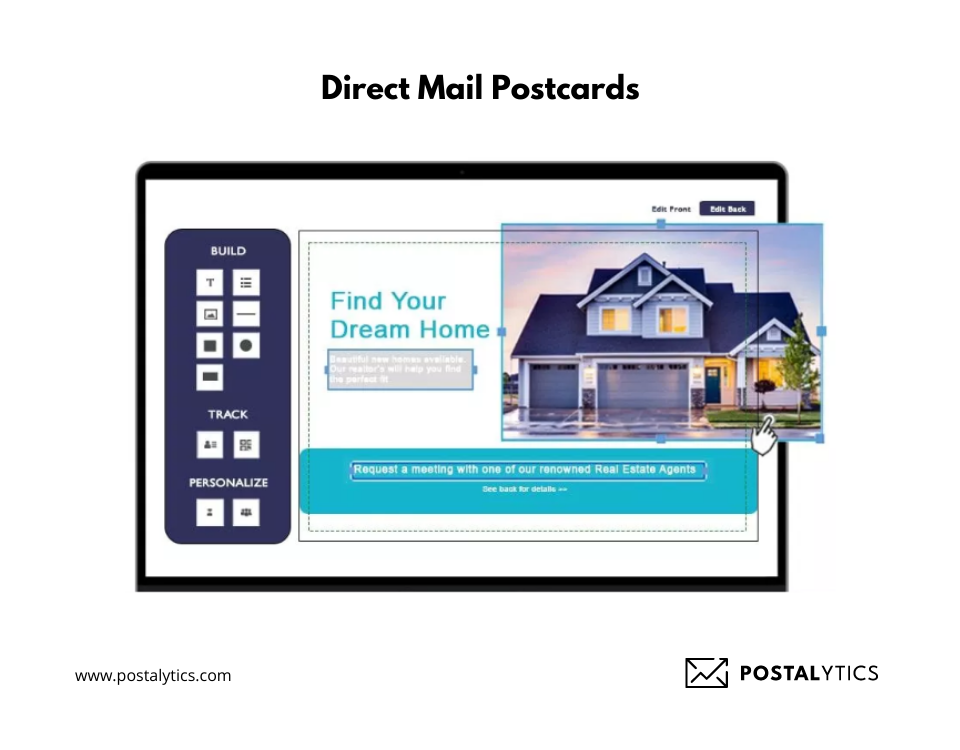
Bi-fold Self Mailers
Self-mailer is a direct mail format that does not require an envelope. This can be a cost-effective method of advertising your product or business. Postalytics now offers this format, so you don’t have to invest much money designing a direct mail piece that could be managed in a self-mailer.
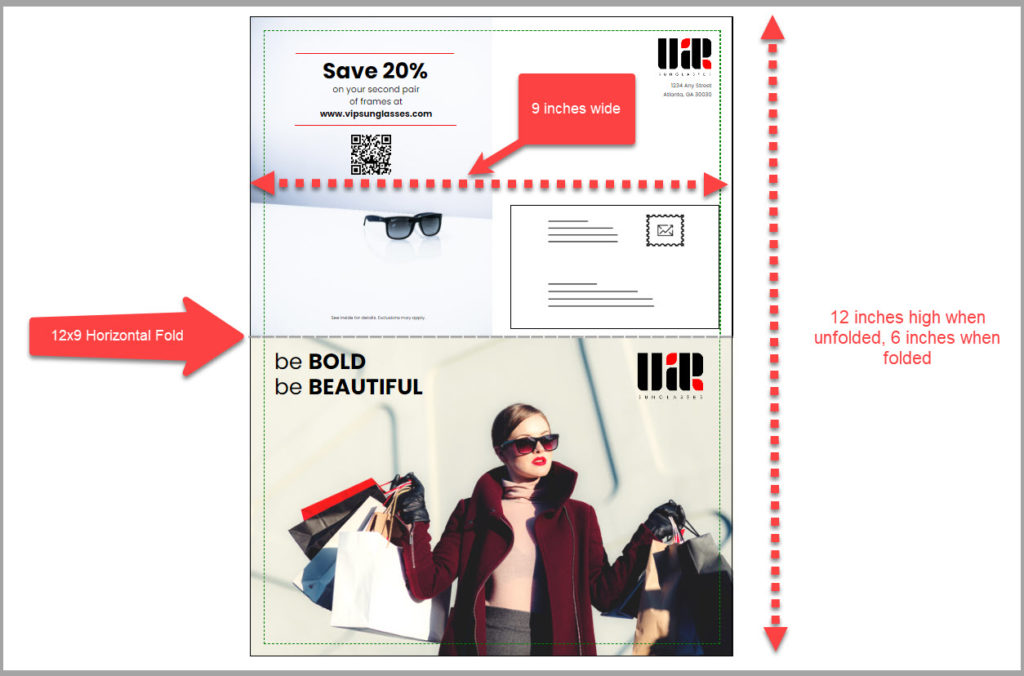
Custom Envelope
Apart from the direct mail pieces, you can create custom envelopes that include your logo, graphics, design, and other design elements. These envelopes can be ordered through the application, stored in inventory, and used in your campaigns. Here are the design specifications for the same.
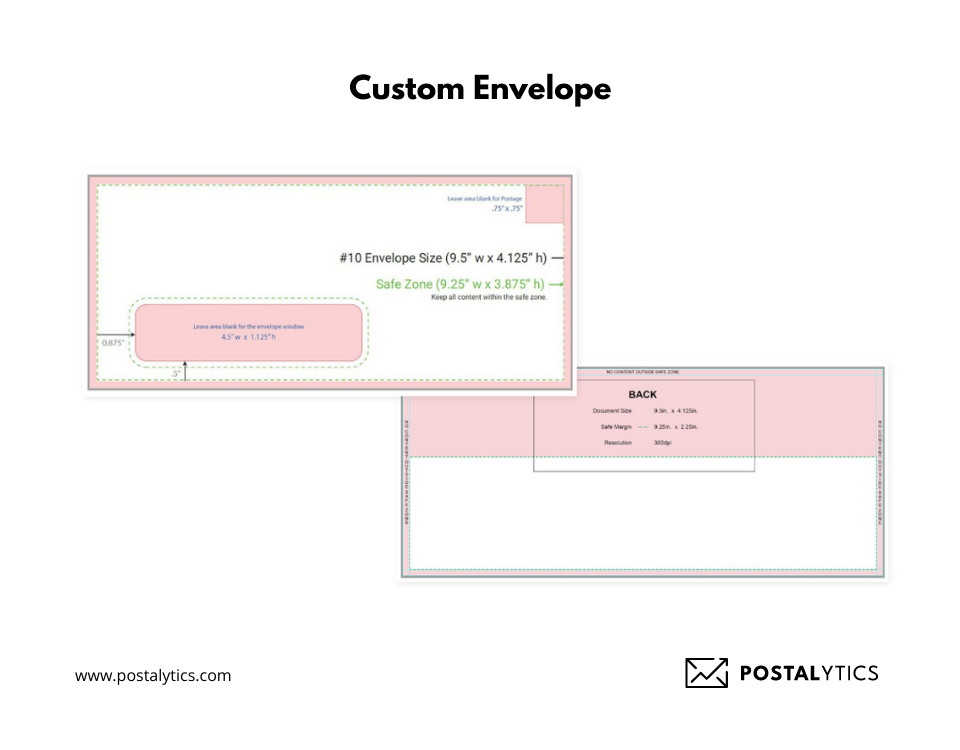
Best Practices for Designing Direct Mail Pieces
Below are five tips to help you create effective direct mail design.
Use Variable Data Printing
Variable Data Printing is a form of printing that allows marketers to develop personalized messages and designs for individual recipients. This personalization could be in the form of changes in imagery, designs, or copies. This helps you improve response rates and build a special connection with the customer.
Pick the Right Colors
When you think of Netflix, which colors do you imagine? Red and black, right? The brand has used those colors in its creatives to incite brand recognition. You can use colors representing your brand and help your customers/prospects associate those tones and patterns with your brand.
Keep Copy Concise
People’s attention span is decreasing daily; to combat this, your direct mail pieces should have a concise yet appealing copy. Keep your sentences short and break down your paragraphs if they exceed seven lines.
Ensure Offer & Call to Action Are Clear
Your offer and CTA are the most important parts of your campaign. And thus, they should be prominent and clearly visible to the recipient. You could use a different font size or style or use colors to highlight it.
Decide on a Finish
As important as your direct mail format is, the texture and finish can go a long way in conveying your message. Depending on your design, the different types of finish you can choose are glossy, satin, soft touch, and uncoated.
Final Thoughts
Direct mail design is integral to creating high-converting campaigns that hit the mark with your target audience. With these tips and strategies, you can develop a design guide for your team to follow, ensuring they produce high-quality deliverables.
Along with that, Postalytics offers you many direct mail creative tools that can make your job easier. With these tools, you can create personalized offers and designs to create targeted campaigns.
Click here to learn more about the different tools Postalytics offers and how you can implement them.
About the Author

Dennis Kelly
Dennis Kelly is CEO and co-founder of Postalytics. Dennis joined Boingnet, the predecessor to Postalytics, in 2013. Boingnet was focused on providing print and direct mail marketing service providers the ability to add digital marketing channels to their direct mail campaigns. Postalytics is Dennis’ 6th startup. He has been involved in starting and growing early-stage technology ventures for over 30 years and has held senior management roles at a diverse set of large technology firms including Computer Associates, Palm Inc. and Achieve Healthcare Information Systems.
